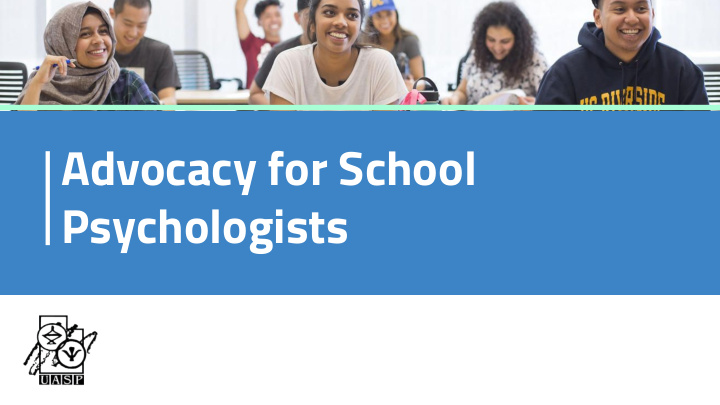



Advocacy for School Psychologists
Topics ▪ What is advocacy ? ▪ What is our ethical responsibility to advocate? ▪ How do we craft our message to be most effective? ▪ What are some helpful tools to assist in our advocacy?
What is advocacy?
What is advocacy? [ad-vuh-kuh-see] the action of pleading for, or supporting a cause or proposal
As school psychologists, we advocate all the time! Today we want to focus on legislative advocacy. ▪ Communicating with decision makers about a specific issue ▪ Asking a lawmaker to support or oppose a specific piece of legislation
Why is Advocacy Important to YOU? ▪ Promotes, maintains, and protects professional identity ▪ Helps ensures empirically based practice and policy ▪ Ensures access to services that will support student success ▪ If we don’t, who will?
“Why do YOU need to advocate?” ▪ There are 535 voting members of Congress ▪ There are over 4.5 million teachers who are members of the NEA and the AFT combined. ▪ If only 10% of NEA/AFT members contacted their elected officials, there would be an average of 421 contacts per member of Congress. ▪ There are 25,000 NASP members . If only 10% of NASP members contact their elected officials, there would be an average of 5 contacts per member of Congress regarding the issues important to school psychologists. ▪ Why should a Congressman care about our issues if there’s only going to be 5 of us knocking on their door?
What is our ethical responsibility to advocate?
“ School psychologists consider the interests and rights of children and youth to be their highest priority in decision making, and act as advocates for all students. These assumptions necessitate that school psychologists ‘speak up’ for the needs and rights of students even when it may be difficult to do so. ” National Association of School Psychologists (2010). Principles for Professional Ethics. Introduction.
How do we craft our message to be most effective?
1. Gather evidence (Research, Data, Examples) ▪ Gather information to help others understand the scope of the problem, barriers, and resources ▪ Research what works and how we know it works (provide the solution) ▪ Be prepared to put a face on the issue ▫ Real stories about kids, families, and educators affected
2. Develop Key Messages and “Ask-Fors” ▪ Keep it to no more than 3 key messages ▫ Problem statement - Students with unaddressed mental and behavioral health problems cannot learn to their fullest potential. ▫ Solution / action - Schools can provide comprehensive mental and behavioral health services to students to support school safety and learning. Ask for/Action: Increased investments in k ey provisions of ESSA are critical to support this work . ▫ Benefit - Students can learn, behave, and be safer when they have access to school-based mental health services and teachers who understand how to support them.
3. Be ready to connect with your audience ▪ Use a story - a personal example ▪ Sometimes these stories are shared or read on the floor of the House or Senate ▪ Avoid jargon or overly technical language ▪ Be ready to be an active listener
What are some helpful tools to assist in our advocacy?
Kids Count - datacenter.kidscount.org Research Tool ▪ Kids Count is an organization that collects data on a large number of child wellbeing factors, including economic well-being, education, health, and safety. ▪ Want to know Utah’s per-pupil expenditures for past 10 years? ▫ Compared to other states? ▪ Want to know how many Utah students participate in free and reduced lunch? ▫ By county?
Voices for Utah Children - utahchildren.org Research Tool ▪ Voices for Utah Children is the Utah-based affiliate of Kids Count that collects information at a county level and publishes information specific to Utah. ▪ Want to know the student-teacher ratio in your county? ▪ Percent of students who are chronically absent by county?
Resist.bot - https://resist.bot Communication Tool
Resist.bot - https://resist.bot Communication Tool ▪ You write your own message - it doesn’t have to be fancy, and it doesn’t have to be perfect. ▫ The occasional typo shows staffers that your message is from a real human and not a copied script. ▪ According to a 2015 Congressional Management Foundation survey of almost two hundred senior congressional staffers, when it comes to influencing a lawmaker’s opinion, personalized e-mails, personalized letters, and editorials in local newspapers all beat out the telephone.
NASP Advocacy Center - cqrcengage.com/naspweb Communication Tool
Virtual Hill Day Combining Our Voices Tool ▪ Instead of physically visiting Utah’s Capitol Hill on a designated day, a Virtual Hill Day asks psychologists to contact their legislators through social media and technology on a designated day! ▪ November 14, 2018 ▫ Gather evidence ▫ Develop key messages ▫ Identify key legislators
We invite you all to ▪ Write one message to legislators set a goal for your via Resist.bot about the need for more school psychologists in Utah legislative advocacy ▪ Participate in the next Virtual Hill efforts this year, day event ▪ Schedule one meeting to visit with even if it’s just one a legislator about how increased thing. funding for school psychologists can help address student’s mental health needs ▪ Call one legislator to ask them to support the Increasing Access to Mental Health in Schools Act
If you have any questions, feel free to contact us! Jason Basinger Sterling Stauffer jason.basinger@gmail.com sterling.stauffer@washk12.org
Recommend
More recommend